If you’re a business owner, you probably know the benefits of carpet steam cleaning. You’ve got stains and allergens to remove, and you don’t have time to spend hours on the floor. But do you know about the health benefits of carpet steam cleaning? If not, you’re about to be surprised! Keep reading to find out what to expect from this cleaning service and how to save money on your carpeting.
Getting rid of stains
Getting rid of stains with carpet steam cleansing is easy once you know what to do. Many stains can be removed using water-based stain removers. These solutions contain a mild detergent, such as Dawn, and a bit of dish soap. These solutions should be applied to the stain with a clean white towel. Wait a couple of minutes, then blot dry with clean water. These solutions are excellent for stubborn grease stains, and some berries can even be removed with vinegar.
If you’ve noticed a blood stain, blot the area with a paper towel or heavy object. You can also use a special carpet stain remover designed to remove specific types of stains. While blotting, you may wish to use a fan to prevent the stain from spreading further. You can also use a wet/dry vac to remove the solvent.
Getting rid of allergens
Despite popular belief, carpets can still be a huge source of allergens, even if you vacuum them regularly. Professional carpet cleaning services have the proper equipment and know-how to effectively remove dust mites, pet dander, and other allergens from your carpets. Even though carpets are a huge source of allergens, steam cleaning them can reduce their numbers in your home, making it healthier for you and your family.
Traditional carpet steam cleaning methods often leave your carpet moist for days, creating a breeding ground for mold and mildew and contributing to allergens. Vacuum steam cleaning is the most effective way to remove these allergens, and this method uses much less water than traditional methods. The carpet dries quickly, and it’s safer to live on than traditional methods. If you’re worried about mold, consider switching to hard surface floors.
Health benefits
Carpet steam cleaning is a great way to ensure that your home is as sanitary as possible, while also reducing the risk of infection. While vacuum cleaners remove most of the dirt and dust that collects on the surface, there is still a large amount of dust that is able to penetrate the carpet. This can make it difficult for people with respiratory allergies to breathe, but a professional cleaning can significantly reduce these allergens and boost the indoor air quality. By removing these buildups, you can enjoy a cleaner home and spend your time doing other things that matter most.

There are also a variety of health benefits to carpet steam cleaning. One of the most important is the reduction of dust mites, which are common household allergens. When carpets are dirty, they can harbor dust mites and other allergens that can cause a variety of respiratory illnesses, including asthma. Steam cleaning can eliminate a large amount of these dangerous organisms by destroying the majority of the dust mite population. The process can even be combined with HEPA filter vacuums to help protect your home from dust mites.
Cost
There are two main types of services, and one of these is steam cleaning. Carpet steam cleaning can be done by either a professional or a do-it-yourselfer. Professional services charge is varying as per square foot. Whether you have an apartment, condominium, or single-family home, a steam cleaning service will need to measure your carpet before estimating the price. If you have a small home, the cost will likely be higher, as travel expenses will be incurred. Meanwhile, larger homes will be cheaper.
Carbonated carpet cleaning is an effective way to deep clean your carpet without having everything wet. Depending on the material of your carpet, carbonated cleaning can cost anywhere. This method is a good option for synthetic carpets made from nylon, olefin, acrylic, or sisal. Natural materials such as cotton, silk, and jute require extra care, and can cost anywhere from 10 to 30 percent more to clean.

